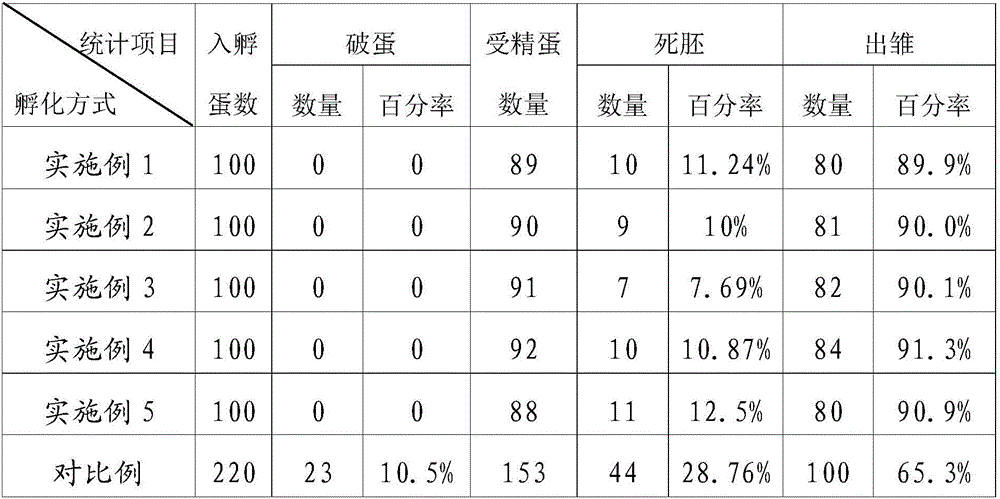Method for artificially hatching pigeon eggs
A technology of artificial hatching and pigeon eggs, applied in the field of meat pigeon breeding, can solve the problems of no pigeons, low hatching rate, inability to effectively improve hatching rate, etc. effect of cycles
- Summary
- Abstract
- Description
- Claims
- Application Information
AI Technical Summary
Problems solved by technology
Method used
Image
Examples
Embodiment 1
[0017] A pigeon egg artificial hatching method is characterized in that, comprises the steps:
[0018] S1. Use a plane incubator to hatch, hatch 100 pigeon eggs at a time, set the hatching temperature at 37.8°C, and set the relative air humidity at 55% during hatching;
[0019] S2. When hatching to the 5th day, carry out the first egg candling, take out the sperm-free eggs and dead sperm eggs;
[0020] S3. When hatching to the 16th day, transfer the pigeon eggs from the planar incubator to the hatcher, maintain the incubation temperature at 37.8°C, adjust the relative humidity of the air to 70%, and ventilate to ensure that the oxygen volume fraction in the air in the hatcher is not high. Less than 18%, most of the young pigeons hatched on the 17th-18th day, and the rest were eggs that were difficult to hatch. Spray a small amount of warm water at 38.5°C on them to moisten the eggs and live before the 19th day. Embryo eggs are basically completely broken.
Embodiment 2
[0022] A pigeon egg artificial hatching method is characterized in that, comprises the steps:
[0023] S1. Use a plane incubator to hatch, hatch 100 pigeon eggs at a time, set the hatching temperature at 38.2°C, and set the relative air humidity at 65% during hatching;
[0024] S2. When hatching to the 5th day, carry out the first egg candling, take out the sperm-free eggs and dead sperm eggs;
[0025] S3. When hatching to the 16th day, transfer the pigeon eggs from the planar incubator to the hatcher, maintain the incubation temperature at 38.2°C, adjust the relative humidity of the air to 80%, and ventilate to ensure that the oxygen volume fraction in the air in the hatcher is not high. Less than 20.5%, most of the young pigeons hatched on the 17th-18th day, and the rest were eggs that were difficult to hatch. Spray a small amount of warm water at 39.5°C on them to moisten the eggs and live before the 19th day. Embryo eggs are basically completely broken.
Embodiment 3
[0027] A pigeon egg artificial hatching method is characterized in that, comprises the steps:
[0028] S1. Use a plane incubator to hatch, hatch 100 pigeon eggs at a time, set the hatching temperature at 37.8°C, and set the relative air humidity at 55% during hatching;
[0029] S2. When hatching to the 5th day, carry out the first egg candling, take out the sperm-free eggs and dead sperm eggs;
[0030] S3. When hatching to the 16th day, transfer the pigeon eggs from the planar incubator to the hatcher, maintain the incubation temperature at 38°C, adjust the relative humidity of the air to 75%, ventilate and blow in oxygen to ensure that the air in the hatcher The oxygen volume fraction is not less than 21.2%. Most of the young pigeons hatch on the 17th-18th day, and the rest are pigeon eggs that are difficult to hatch. Before 19 days, live embryonated eggs were basically completely broken.
PUM
 Login to View More
Login to View More Abstract
Description
Claims
Application Information
 Login to View More
Login to View More - Generate Ideas
- Intellectual Property
- Life Sciences
- Materials
- Tech Scout
- Unparalleled Data Quality
- Higher Quality Content
- 60% Fewer Hallucinations
Browse by: Latest US Patents, China's latest patents, Technical Efficacy Thesaurus, Application Domain, Technology Topic, Popular Technical Reports.
© 2025 PatSnap. All rights reserved.Legal|Privacy policy|Modern Slavery Act Transparency Statement|Sitemap|About US| Contact US: help@patsnap.com

